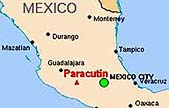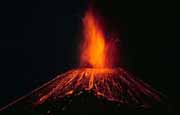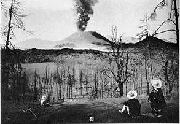
The eruption of the Paricutin scoria cone from 1943 to 1952 marks the first time scientists were able to observe the complete life cycle of a volcano, from birth to extinction. Geologists from many parts of the world came to study this extraordinary volcanic event. The knowledge gained by these scientists greatly expanded our understanding of volcanism in general, and of scoria-cone formation in particular. The most recent, detailed description of this classic eruption is in the book "Paricutin: the volcano born in a Mexican cornfield" published in 1993 and edited by Jim Luhr and Tom Simkin of the Smithsonian Institution.

|
Paricutin is located about 200 miles west of Mexico City. It is the youngest of 1,400 volcanic vents in the Michoacan-Guanajuato volcanic field, a basalt plateau dominated by scoria cones, but also containing small shield volcanoes, maars, tuff rings, and lava domes. |
Three weeks before the eruption, the people near Paricutin village heard the rumbling noises that resembled thunder, yet they were confused because the skies were clear of clouds. The noises were associated with earthquakes at depth near Paricutin. On February 20, 1943 a farmer, Dionisio Pulido, and his wife Paula were burning shrubbery in their cornfield when they observed the earth in front of them swell upward and crack to form a fissure 2-2.5 m across. They heard hissing sounds and later described the rise of "smoke" from the fissure, which had the repugnant smell of rotten eggs. The "rotten egg" smell is a hallmark of H2S gas, and the crack that opened in front of them would, within hours, develop into a small volcano. In Dioniso Pulido's own words:
Strombolian pyroclastic activity began at the fissure on the day it was discovered by Dionisio Pulido. Within 24 hours the eruption had generated a 50-m-high scoria cone. Within a week, it had grown to a height of 100 m from the accumulation of bombs and lapilli, and finer fragments of ash were raining down on the village of Paricutin. The eruption became more powerful in March, generating eruptive columns several kilometers high. Occassionally, the volcano would exhibit vulcanian-type activity, with large canon-like explosions separated by short periods of silence. On June 12, a lobe of lava began to advance toward Paricutin village and people began to evacuate the village the following day. The larger village of San Juan Parangaricutiro was evacuated a few months later. By August 1944, most of the villages of Paricutin and San Juan were covered in lava and ash. All that remained of San Juan were two church towers that stood above a sea of rugged lava.

|

|
|
|
|
The Paricutin eruption was unusually long for a strombolian eruption, with several eruptive phases occurring over a 9-year period. After about two years of mostly pyroclastic activity the pyroclastic phase began to wane, and the outpouring of lava from the base of the cone became the dominant mode of eruption over the next 7 years. Although no people died directly from the eruption, three people died after being struck by lightning generated by the pyroclastic eruptions. The eruption ceased in 1952. The final height of the scoria cone was 424 m.